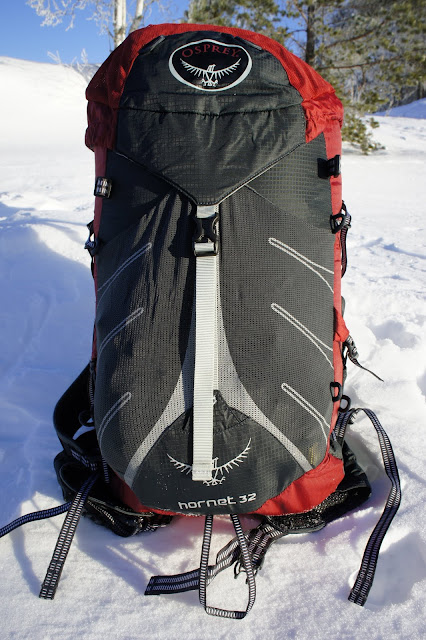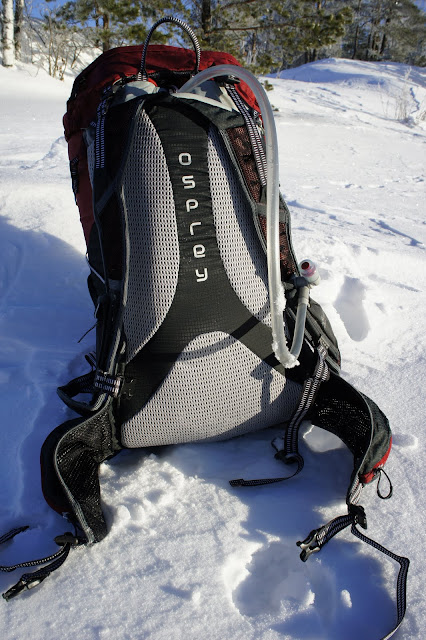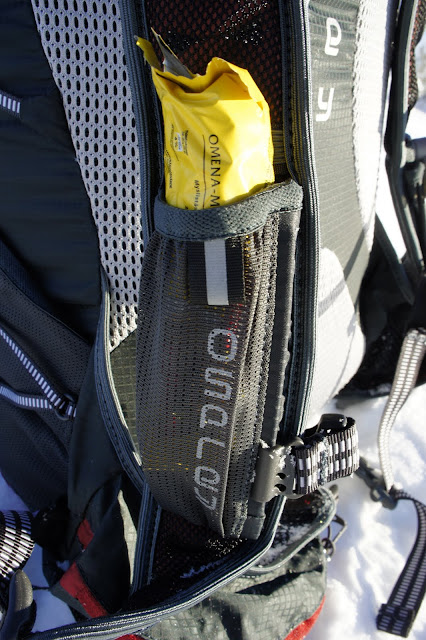It should be called "Snowmobile Assisted Skiing Trip" Report, but snowmobiles are for morons so lets scrap that! 2nd trip of the education to become a wilderness guide. Another group trip. Take a cup of tea and a cookie, this is a long post.

Saturday morning.
The trip was twelve days for the other students, due to personal reasons I skipped the first five days, in which snowmobile driving, theory and stuff were on the curriculum. I don't have a driving license, and am not interested in snowmobiles, so instead of learning about things which would not help me much in the future (I think it is good to have a foundation and know the basics, how the machine works, don't get me wrong - though due to personal circumstances needed to skip it). Arrived Friday evening in Nurmes, eastern Finland, a sunny, fine day. Checking in to the hostel, and I hear that there's a good meter of snow with lots of powder. Hmmm, that could mean problems as I took my Madshus Glittertind skis. Well, best to see for myself. I strap on my skis and turn a round, and then switch to the Metsäsukset (230 - 280 cm long skis, 7 cm wide, cable bindings, to be skied with rubberboots) which the others use and do another round. Result: Absolutely the same floatation, just that my skis are more ergonomic and easier to use (for me). Bien!

Saturday morning, breakfast and off we go to Nurmijärvi, a tiny village not far from the border, nestled along the Jongunjoki river and plenty of lakes. Erästely is a Canoe & Outdoor business in the village, and we park our cars there and start the unpacking/ repacking. It always takes time, and with gear needing to be divided between two snowmobile trailers and two pulkas for the skiers, we spent some good time packing.

Unpacking and repacking at Erästely.
The idea of the trip was to learn a) snowmobile skills, b) skiing skills, and c) winter skills. Daily Guides would rotate and switch between skis in the morning/ snowmobile in the afternoon; and all the main gear (mats, sleeping bags, army tent & stove, food, extra clothes, etc.) is transported by the snowmobiles, while the skiers only carry a backpack with their daily gear (puffy jackets, snacks, thermos, food, etc.). Then there also were be two pulkas for the skiers, which carried some survival gear, and the skiers rotated pulling them. Anyway, I decided to pull my own gear all the time in my own pulka, a Fjellpulken XCountry 130. I saw this trip as a test run for the nine day solo ski trip in Hammastunturi which is again part of the education.

The Swedish Army pulka.
Around 11.30 o'clock we finally started skiing, beautiful weather at crisp temperatures made for great skiing. We saw a 22° solar halo most of the day, and the skiing over lakes and bogs, through forests and crossing roads and snowmobile tracks was good fun. The trees were covered in nearly 50 cm of snow and looked majestic against the blue sky.

22° halo.



Daily guide tests a lake's ice.
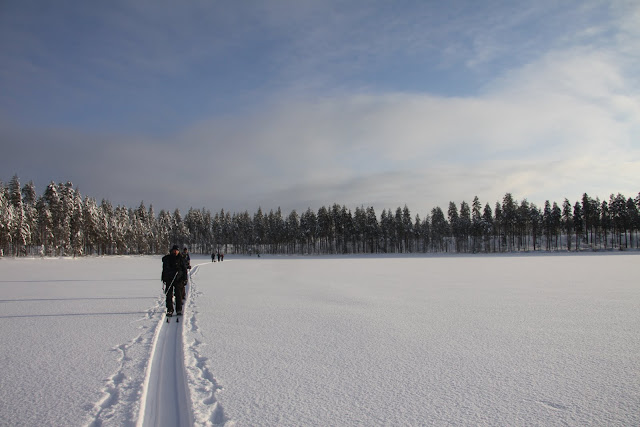
Skiing in line.
While the skiing was fun, it took us very long. Some of the other students aren't yet that good with skis, let alone pulling a heavy pulka, so time went with people learning how to ski with it. I went on a few training skis with my pulka at home, so had a good idea of what laid ahead. We missed our lunch schedule, and snacks were consumed to have power to keep going, which made us slower and slower.

As dusk arrived, so did we at the campsite designated for lunch. As we heard from our two classmates who were on the snowmobiles, they had an accident and one of the snowmobiles and one trailer needed fixing. The teacher crashed into the trailer of the other snowmobile, and a mechanic needed to come in to help fix it so that we can continue our journey. It was late already, the first stars were coming out and the temperature fell more and more, so plans were changed and we would stay at this site for the night. The snowmobile guides, aware that we were a hungry bunch of skiers, had already two fires going and were soon serving us "lunch". The army tent was erected, firewood from the swamp collected, sleeping places in the army tent were claimed, all while the waxing moon was illuminating the forests, lakes and bogs around us.

Dusk over the swamp.
The temperature fell to -31°C that night, slightly more than was predicted. Which was one of the reasons that I decided to sleep in the group army tent and not under a tarp or pyramid shelter that night (the other reason being that I was too tired to dig a place to pitch either on my own). And while we had a stove in the tent, the decision was made that we will not have a fire watch this first night. Nevertheless I was warm and comfortable under my quilt, though sleeping in a tent with ten other people is "sub-optimal" for me. I need absolute silence to sleep comfortably (I don't mind nature's sounds), so the night was spent in a comatose state of trying to sleep, and while this would make for an unproductive next day in civilization, I am able to cope with it in nature.
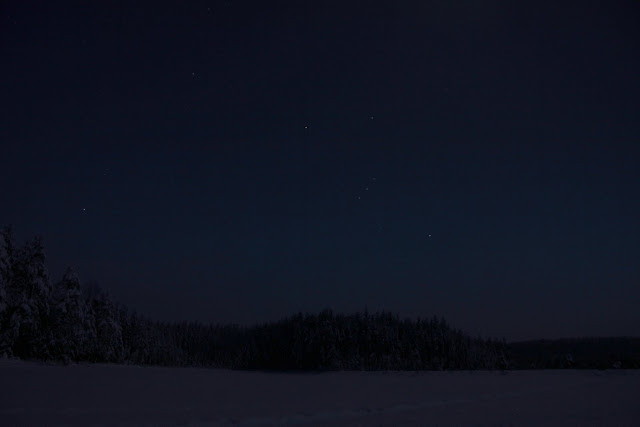
Nightfall.
The breakfast, porridge, while not one of my favourites, gave energy for the day ahead. The day ahead meant 15 km of skiing, and with perfect sunshine that was looking like going to be a great day. We crossed bogs and lakes, traversed little hills in the forest, skied along forest roads covered in plenty of snow, and then skied over a massive swamp in a beautiful straight line while the wind was relentless, gathering speed in this vast open space, looking for exposed skin to freeze.
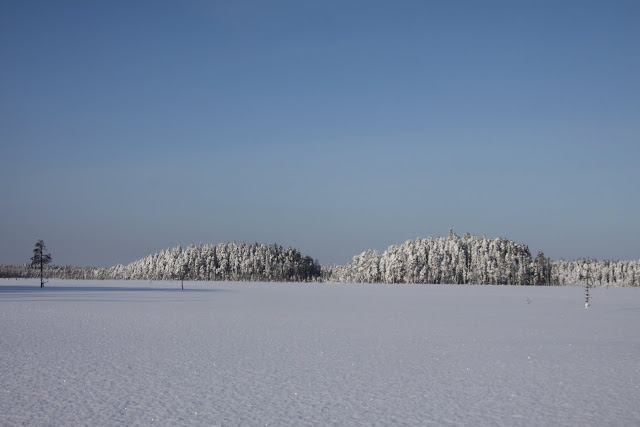
We skied for a good five hours, which equalled about nine kilometers (all off-piste, in case you wonder about our speed) before we reached our lunch place. The snowmobile guides were already busy cooking and had prepared a fine seating area including trench and reindeer skins around a fire, where we sat in our puffy jackets waiting for the food to be ready. The interesting thing is, that after skiing such a distance in such cold, you're so hungry that you eat with gusto anything that's set in front of you. In this case, pasta with spam!
Now cooking at minus temperatures brings a whole new set of challenges with it. If I'd travel private or solo, my meals would be dehydrated or freeze-dried for convenience and quickness, though with the limited budget (and time to some extent) the planning group had this was not possible or feasible. Now, at -25°C everything is frozen and using it a challenge, let alone eating it while it is hot. Think rock-hard butter, oil, cheese, bread, meat, fish and so on. The only thing which wasn't frozen solid was pasta. You have about three to five minutes to eat your food before it is cold and frozen to your pot at these temperatures, cleaning up means that the time it took me to grab a piece of paper to dry my pot after rinsing was enough to freeze the water in the pot - we speak seconds here. This is not complaining for those who do not know me, merely stating the facts. It is hard to cook in these conditions, more so if you need to cook for 13 people.
After a good lunch, refilling the thermos and a final hot cup of coffee the journey continued, another six kilometers to cover. The sun was already setting by the time we left the lunch place, that warm globe in the sky slowly going down.
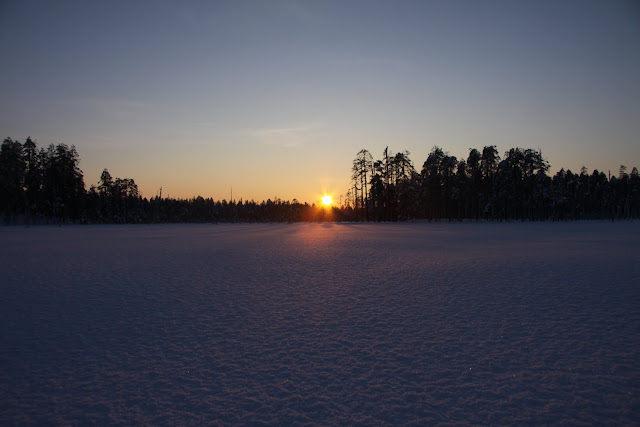
Sunset on Sunday.
We again crossed vast bogs and lakes with the occasional forest in between, and for a while even traveling on the Karhunpolku, a 133 km long trail along the Finnish-Russian border (and this will be a trail to bring me back to the east in the summer, splendid looking!). As soon as the sun sets and starts to colour the sky in red, orange and pink before letting the dark blue and black of night takes over, the temperature drops rapidly. Skiing in the sun is warm, small breaks of a few minutes can be handled without putting an extra insulation layer on, though once the sun is gone the thermometer starts to enter the realm of -30°C and more, making breaks a freezing pain.

It is getting cooler in these breaks.
We continued skiing at good speed, which is necessary to keep warm, and the waxing moon gave us enough light to leave the headlamps off while following in the trail of the daily guide. I was smiling in pleasure at the beautiful scenery, while little breaks to take a bearing started to take an effect on my feet and hands. Skiing to camp, where a dinner should be waiting, was all I wanted.
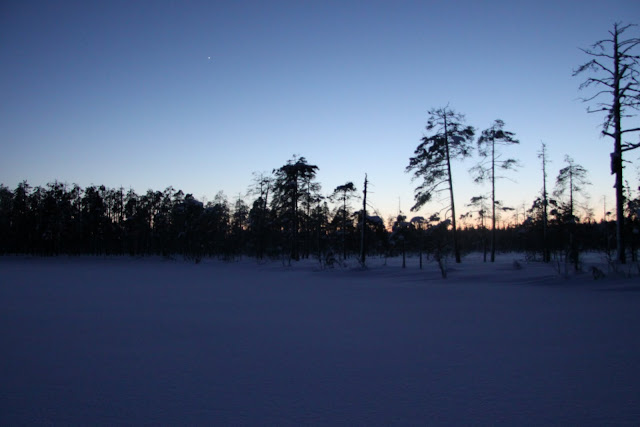
Final light.
Around six-ish we arrived at the campsite, to find out that the wood the snowmobile guides found was pretty moist and it was hard to start a fire let alone to cook (no fire = no boiling water = no food). Well, time to put that army tent up to stay warm, exercise is what keeps your body temperature up. And here's where things started to go downhill for me. I was late with ordering my Forty Below Light Energy overboots and didn't have them with me, so I stayed in my skiboots to do the work. Big mistake, especially at -34°C. By 20.30 o'clock I couldn't take it any longer, headed into the army tent and took off boots and socks. The light of my headlamp illuminated what my body told me already, and my mind expected: Frostbite. The toes where half-white and a bit numb. I am very lucky indeed, as one of my classmates is a nurse - a quick shout brought her over, she confirmed the condition, and was setting out to warm my feet with her hands. I put on dry socks and my BPL Cocoon pants and hoody, and my mate was so generous to loan me his Sorel boots. The teacher appeared, looking worried and recommended I should go for a run to exercise the feet, to animate the blood circulation in the extremities. I did this, and it started to feel a bit warmer. Around ten-ish dinner was finally served, which helped fuel my internal engine, and delicious it was - veggies, fish patties and mashed potatoes taste fantastic after a hard day skiing.
One of my classmates was equally cold, and our teacher checked with everyone else how he/ she felt. Cold toes and hands all around, but no-one as badly as me. Ah well. The stove was kept going this night, and with -34°C outside that was a welcomed decision, even if it meant for everyone in turn to wake up at night to keep the fire going.

The next morning.
The next morning came, and as Monday was a rest day people were sleeping out. My night's sleep was again as unruly as the previous night, though I had a bit of sleep nevertheless. I rose to go for a run, as my toes, while no longer being white, were still sensitive and cold. Sunshine was greeting me, and it was getting warmer by the minute. I helped make breakfast, that delicious porridge, while sawing and chopping wood to keep the fires going. I then decided to go for a ski trip around the forest, to see how it would go.

Well, it was OK. Cold in the boots, and the movement was a tad painful. It was good to be back at camp and switch into the Sorels of my mate, and have another cup of coffee. One of the students, who felt extremely cold, arranged to be "evacuated". The teacher took him out via the snowmobile, while the rest of us - the remaining nine (we had one drop-out on Sunday due to personal circumstances) were wondering who would leave the next day.

Firewood and moon.
That wondering and joking soon took another route. The teacher called in from basecamp, and asked if there's anyone else who'd like to be "evacuated". After everyone said they'd stay, I was put on the phone with the teacher, who asked how my toes are and if I want to leave. I answered honestly that while my toes are sensitive I think I'd cope, though the conversation went on which led to me asking our nurse for advice. She thought it be a good idea to spent the next two days and nights inside, and hearing her advice I made the decision. As the teacher called back as agreed, I said that yes, he can take me out. I started packing, ate another great lunch (reindeer cheese soup and toasties!) and waited for the teacher.
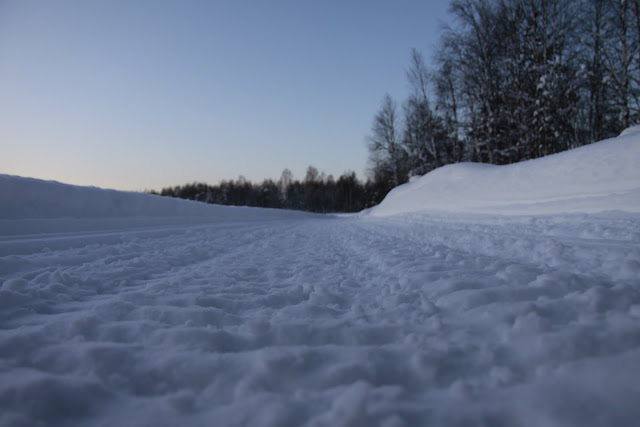
The snowmobile ride back to Erästely was beautiful but cold. The owners welcomed me warmly with a cup of tea and showed me my room. I went to read, but fell asleep pretty much right away, only to wake up at 23 o'clock to realize that I fell asleep over my book with the lights on. Two bad nights sleep do that to you! I used the two next days to walk through the village, eat, read, sleep, tweet, dry my gear, and get ready for the ride back to Nurmes.
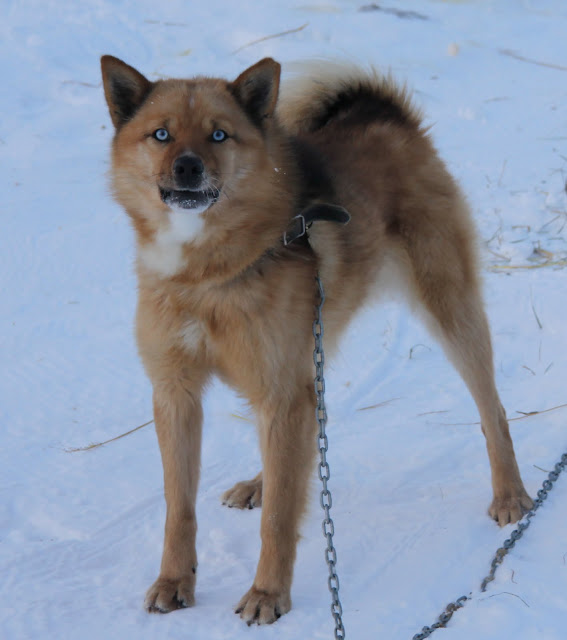
Which leads us to the conclusion. Yes, it was a hard decision to say "I'm out" though in my book ten toes are better than being the tough (dumb and toeless) guy. It was not smart from me to do the work in my skiboots, as it are skiboots and not made for kicking holes for snow anchors and walking around. I should have either switched in my Inov-8s + GoreTex over-socks as we arrived at camp, or used VBLs, or asked my mate right away if I might slip in his Sorels. Afterwards you're always smarter.
I knew that there would be some comments afterwards from the teacher, "enlightening" me that sometimes light isn't right. The light gear wasn't appropriate. I concur to some extent, though if you should have a fire and dinner at 18 o'clock and you have neither that is also something add to the equation. Add in that the temperature was far colder than expected (yeah yeah, never trust the weather forecast =) and I think the light gear, while being part of the reason, is not the sole reason.

On Sunday I leave for three weeks of skiing and snowshoeing as a guide in north-east Finland. I will add overboots. I am taking some warm camp footwear. All of it is light. We will see if it is right.

Saturday morning.
The trip was twelve days for the other students, due to personal reasons I skipped the first five days, in which snowmobile driving, theory and stuff were on the curriculum. I don't have a driving license, and am not interested in snowmobiles, so instead of learning about things which would not help me much in the future (I think it is good to have a foundation and know the basics, how the machine works, don't get me wrong - though due to personal circumstances needed to skip it). Arrived Friday evening in Nurmes, eastern Finland, a sunny, fine day. Checking in to the hostel, and I hear that there's a good meter of snow with lots of powder. Hmmm, that could mean problems as I took my Madshus Glittertind skis. Well, best to see for myself. I strap on my skis and turn a round, and then switch to the Metsäsukset (230 - 280 cm long skis, 7 cm wide, cable bindings, to be skied with rubberboots) which the others use and do another round. Result: Absolutely the same floatation, just that my skis are more ergonomic and easier to use (for me). Bien!
Saturday morning, breakfast and off we go to Nurmijärvi, a tiny village not far from the border, nestled along the Jongunjoki river and plenty of lakes. Erästely is a Canoe & Outdoor business in the village, and we park our cars there and start the unpacking/ repacking. It always takes time, and with gear needing to be divided between two snowmobile trailers and two pulkas for the skiers, we spent some good time packing.

Unpacking and repacking at Erästely.
The idea of the trip was to learn a) snowmobile skills, b) skiing skills, and c) winter skills. Daily Guides would rotate and switch between skis in the morning/ snowmobile in the afternoon; and all the main gear (mats, sleeping bags, army tent & stove, food, extra clothes, etc.) is transported by the snowmobiles, while the skiers only carry a backpack with their daily gear (puffy jackets, snacks, thermos, food, etc.). Then there also were be two pulkas for the skiers, which carried some survival gear, and the skiers rotated pulling them. Anyway, I decided to pull my own gear all the time in my own pulka, a Fjellpulken XCountry 130. I saw this trip as a test run for the nine day solo ski trip in Hammastunturi which is again part of the education.

The Swedish Army pulka.
Around 11.30 o'clock we finally started skiing, beautiful weather at crisp temperatures made for great skiing. We saw a 22° solar halo most of the day, and the skiing over lakes and bogs, through forests and crossing roads and snowmobile tracks was good fun. The trees were covered in nearly 50 cm of snow and looked majestic against the blue sky.

22° halo.


Daily guide tests a lake's ice.
Skiing in line.
While the skiing was fun, it took us very long. Some of the other students aren't yet that good with skis, let alone pulling a heavy pulka, so time went with people learning how to ski with it. I went on a few training skis with my pulka at home, so had a good idea of what laid ahead. We missed our lunch schedule, and snacks were consumed to have power to keep going, which made us slower and slower.
As dusk arrived, so did we at the campsite designated for lunch. As we heard from our two classmates who were on the snowmobiles, they had an accident and one of the snowmobiles and one trailer needed fixing. The teacher crashed into the trailer of the other snowmobile, and a mechanic needed to come in to help fix it so that we can continue our journey. It was late already, the first stars were coming out and the temperature fell more and more, so plans were changed and we would stay at this site for the night. The snowmobile guides, aware that we were a hungry bunch of skiers, had already two fires going and were soon serving us "lunch". The army tent was erected, firewood from the swamp collected, sleeping places in the army tent were claimed, all while the waxing moon was illuminating the forests, lakes and bogs around us.
Dusk over the swamp.
The temperature fell to -31°C that night, slightly more than was predicted. Which was one of the reasons that I decided to sleep in the group army tent and not under a tarp or pyramid shelter that night (the other reason being that I was too tired to dig a place to pitch either on my own). And while we had a stove in the tent, the decision was made that we will not have a fire watch this first night. Nevertheless I was warm and comfortable under my quilt, though sleeping in a tent with ten other people is "sub-optimal" for me. I need absolute silence to sleep comfortably (I don't mind nature's sounds), so the night was spent in a comatose state of trying to sleep, and while this would make for an unproductive next day in civilization, I am able to cope with it in nature.
Nightfall.
The breakfast, porridge, while not one of my favourites, gave energy for the day ahead. The day ahead meant 15 km of skiing, and with perfect sunshine that was looking like going to be a great day. We crossed bogs and lakes, traversed little hills in the forest, skied along forest roads covered in plenty of snow, and then skied over a massive swamp in a beautiful straight line while the wind was relentless, gathering speed in this vast open space, looking for exposed skin to freeze.
We skied for a good five hours, which equalled about nine kilometers (all off-piste, in case you wonder about our speed) before we reached our lunch place. The snowmobile guides were already busy cooking and had prepared a fine seating area including trench and reindeer skins around a fire, where we sat in our puffy jackets waiting for the food to be ready. The interesting thing is, that after skiing such a distance in such cold, you're so hungry that you eat with gusto anything that's set in front of you. In this case, pasta with spam!
Now cooking at minus temperatures brings a whole new set of challenges with it. If I'd travel private or solo, my meals would be dehydrated or freeze-dried for convenience and quickness, though with the limited budget (and time to some extent) the planning group had this was not possible or feasible. Now, at -25°C everything is frozen and using it a challenge, let alone eating it while it is hot. Think rock-hard butter, oil, cheese, bread, meat, fish and so on. The only thing which wasn't frozen solid was pasta. You have about three to five minutes to eat your food before it is cold and frozen to your pot at these temperatures, cleaning up means that the time it took me to grab a piece of paper to dry my pot after rinsing was enough to freeze the water in the pot - we speak seconds here. This is not complaining for those who do not know me, merely stating the facts. It is hard to cook in these conditions, more so if you need to cook for 13 people.
After a good lunch, refilling the thermos and a final hot cup of coffee the journey continued, another six kilometers to cover. The sun was already setting by the time we left the lunch place, that warm globe in the sky slowly going down.
Sunset on Sunday.
We again crossed vast bogs and lakes with the occasional forest in between, and for a while even traveling on the Karhunpolku, a 133 km long trail along the Finnish-Russian border (and this will be a trail to bring me back to the east in the summer, splendid looking!). As soon as the sun sets and starts to colour the sky in red, orange and pink before letting the dark blue and black of night takes over, the temperature drops rapidly. Skiing in the sun is warm, small breaks of a few minutes can be handled without putting an extra insulation layer on, though once the sun is gone the thermometer starts to enter the realm of -30°C and more, making breaks a freezing pain.

It is getting cooler in these breaks.
We continued skiing at good speed, which is necessary to keep warm, and the waxing moon gave us enough light to leave the headlamps off while following in the trail of the daily guide. I was smiling in pleasure at the beautiful scenery, while little breaks to take a bearing started to take an effect on my feet and hands. Skiing to camp, where a dinner should be waiting, was all I wanted.
Final light.
Around six-ish we arrived at the campsite, to find out that the wood the snowmobile guides found was pretty moist and it was hard to start a fire let alone to cook (no fire = no boiling water = no food). Well, time to put that army tent up to stay warm, exercise is what keeps your body temperature up. And here's where things started to go downhill for me. I was late with ordering my Forty Below Light Energy overboots and didn't have them with me, so I stayed in my skiboots to do the work. Big mistake, especially at -34°C. By 20.30 o'clock I couldn't take it any longer, headed into the army tent and took off boots and socks. The light of my headlamp illuminated what my body told me already, and my mind expected: Frostbite. The toes where half-white and a bit numb. I am very lucky indeed, as one of my classmates is a nurse - a quick shout brought her over, she confirmed the condition, and was setting out to warm my feet with her hands. I put on dry socks and my BPL Cocoon pants and hoody, and my mate was so generous to loan me his Sorel boots. The teacher appeared, looking worried and recommended I should go for a run to exercise the feet, to animate the blood circulation in the extremities. I did this, and it started to feel a bit warmer. Around ten-ish dinner was finally served, which helped fuel my internal engine, and delicious it was - veggies, fish patties and mashed potatoes taste fantastic after a hard day skiing.
One of my classmates was equally cold, and our teacher checked with everyone else how he/ she felt. Cold toes and hands all around, but no-one as badly as me. Ah well. The stove was kept going this night, and with -34°C outside that was a welcomed decision, even if it meant for everyone in turn to wake up at night to keep the fire going.
The next morning.
The next morning came, and as Monday was a rest day people were sleeping out. My night's sleep was again as unruly as the previous night, though I had a bit of sleep nevertheless. I rose to go for a run, as my toes, while no longer being white, were still sensitive and cold. Sunshine was greeting me, and it was getting warmer by the minute. I helped make breakfast, that delicious porridge, while sawing and chopping wood to keep the fires going. I then decided to go for a ski trip around the forest, to see how it would go.
Well, it was OK. Cold in the boots, and the movement was a tad painful. It was good to be back at camp and switch into the Sorels of my mate, and have another cup of coffee. One of the students, who felt extremely cold, arranged to be "evacuated". The teacher took him out via the snowmobile, while the rest of us - the remaining nine (we had one drop-out on Sunday due to personal circumstances) were wondering who would leave the next day.

Firewood and moon.
That wondering and joking soon took another route. The teacher called in from basecamp, and asked if there's anyone else who'd like to be "evacuated". After everyone said they'd stay, I was put on the phone with the teacher, who asked how my toes are and if I want to leave. I answered honestly that while my toes are sensitive I think I'd cope, though the conversation went on which led to me asking our nurse for advice. She thought it be a good idea to spent the next two days and nights inside, and hearing her advice I made the decision. As the teacher called back as agreed, I said that yes, he can take me out. I started packing, ate another great lunch (reindeer cheese soup and toasties!) and waited for the teacher.
The snowmobile ride back to Erästely was beautiful but cold. The owners welcomed me warmly with a cup of tea and showed me my room. I went to read, but fell asleep pretty much right away, only to wake up at 23 o'clock to realize that I fell asleep over my book with the lights on. Two bad nights sleep do that to you! I used the two next days to walk through the village, eat, read, sleep, tweet, dry my gear, and get ready for the ride back to Nurmes.
Which leads us to the conclusion. Yes, it was a hard decision to say "I'm out" though in my book ten toes are better than being the tough (dumb and toeless) guy. It was not smart from me to do the work in my skiboots, as it are skiboots and not made for kicking holes for snow anchors and walking around. I should have either switched in my Inov-8s + GoreTex over-socks as we arrived at camp, or used VBLs, or asked my mate right away if I might slip in his Sorels. Afterwards you're always smarter.
I knew that there would be some comments afterwards from the teacher, "enlightening" me that sometimes light isn't right. The light gear wasn't appropriate. I concur to some extent, though if you should have a fire and dinner at 18 o'clock and you have neither that is also something add to the equation. Add in that the temperature was far colder than expected (yeah yeah, never trust the weather forecast =) and I think the light gear, while being part of the reason, is not the sole reason.
On Sunday I leave for three weeks of skiing and snowshoeing as a guide in north-east Finland. I will add overboots. I am taking some warm camp footwear. All of it is light. We will see if it is right.
